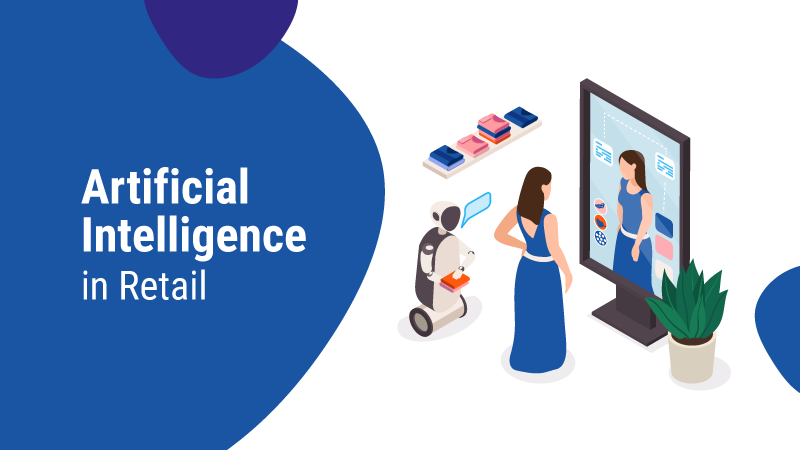Digitalization in the retail industry has been evolving every day for years, which resulted in increased speed, performance, and efficiency across all segments of the retail business. Predictive analytic systems and high-level data have led companies to make data-based marketing decisions. Almost all industries are interested in AI as the profit offered by this innovative AI technology is immense. Among others, there is an increasing demand for AI in the retail industry. The application of artificial intelligence in retail facilitates a better shopping experience for customers and the advantages are many which are going to be discussed in this article.
Uses of AI in Retail
Artificial Intelligence services have contributed a lot of profits in the retail industry; However, here are some basics that retail professionals can rely on:
Visual and voice search
Customers may find it difficult to visit a shop and make a purchase of the product they have in mind. They may face a lot of trouble while making the salesman or shopkeeper understand what they are actually looking for. Visual search features offered by AI make the process so easy and smooth. Customers simply have to upload a picture of a product they are looking for and you will get a list of similar products depending on the shape, color, size, and pattern. Likewise, there is a voice search option in which the customers have to give commands through their voice. The system will analyze the voice and give appropriate results based on the command. This works just like the way you explain things to a shopkeeper. Both these features save a lot of time during shopping and customers can easily pick the product of their choice without any tension.
Virtual trial and decision-making
When it comes to purchasing products, AI provides business insights for retailers in order to help them make quick decisions. For instance, you may feel tired and irritated while trying out different clothes in a physical retail store. AI-induced virtual trial rooms can save you from this frustration as they have digital mirrors that enhance the decision-making power of the customers. Customers can make use of a touch-based screen, choose any option like dresses, shoes, etc., and can pick the one that looks good on them. This same technique can be used even while selecting cosmetics too. These virtual fitting rooms not only save time for offline and online customers but also help them to pick the perfect dress that matches all the elements.
Product categorization
AI uses its machine learning capabilities to categorize more than one million products from different vendors. Machine learning-induced systems tag products and classify them into different categories for the convenience of customers looking for a specific product. The ML-driven software with computer vision easily identifies, classifies, and prices the product to be sold, based on the pictures uploaded by the vendor. One of the best examples is Lalafo, a platform that can process over 900 requests per second, enhancing sales with significant content using machine learning models.
Price predictions and adjustments
Price prediction refers to the process of forecasting the price of products on the basis of the item’s demand in the market, seasonal trends, features, the launch date of updated models of the same product, etc. Artificial intelligence gives retailers the opportunity to see the end result of different pricing strategies. This way they can introduce promotional offers, gain more customers, and boost sales. To implement this, systems gather information on promotional activities, selling prices, and relevant data about other products. AI thus helps businesses to predict prices to improve customer loyalty and optimize prices on the basis of the information obtained by the system.
Consistent experience across channels
If the information is not consistent across different channels, then it leads to less customer satisfaction and experience. For example, imagine the trouble a customer would have to face if the product bought online is shown out of stock at the collection point. This happens when the retailer tries to sell more than he has on hand. AI and ML help to optimize stock, automate inventory fill-ups, and optimize pricing to increase revenue. Artificial intelligence solutions not only minimize out-of-stock rates by up to 80% but also improve returns and profits by more than 5%. This will help customers to expand their omnichannel experience.
Customer behavior prediction
Artificial intelligence platforms allow entrepreneurs to utilize behavioral economics to develop a personalized approach to every customer. Such artificial intelligence platforms use an algorithm that processes the behavioral patterns and emotional reactions of the customer from past shopping experiences and brings the most favorable pricing offers to a specific visitor. This intelligent incentive platform maximizes purchases by evaluating the psychology and emotions of every customer.
Common Benefits of AI in Retail
Here are some of the common benefits of AI for retailers and customers:
- Customers don’t have to wait in a long queue for billing or purchase.
- It saves time and satisfies the customer’s needs in minutes.
- AI-driven virtual assistants to help during the purchase.
- It maximizes the revenue while holding the marginal profit tightly.
- High customer satisfaction and smooth functioning.
- Offer personalized experiences to the customers.
- Maintains and re-fills the inventory.
Wrap Up
The retail industry is trying to extract the power of artificial intelligence technology to achieve business benefits. The implementation of artificial intelligence provides an opportunity for retailers to become strong competitors in the industry. This article tries to explain the major benefits of using AI in the retail industry. Automated processes, improved statistics for your business, and better customer service in the retail industry – all are results of AI.
